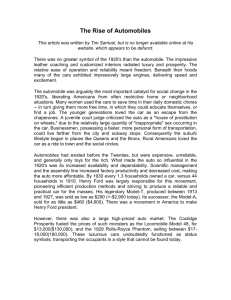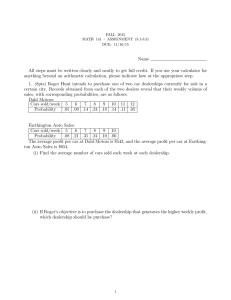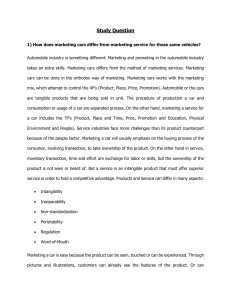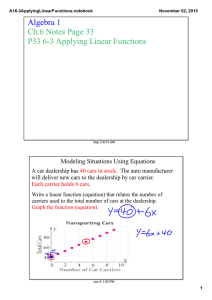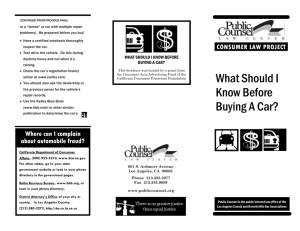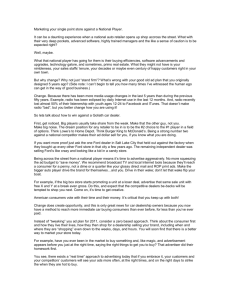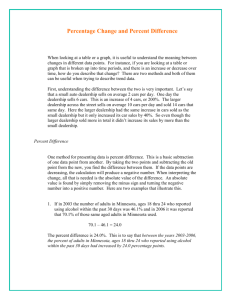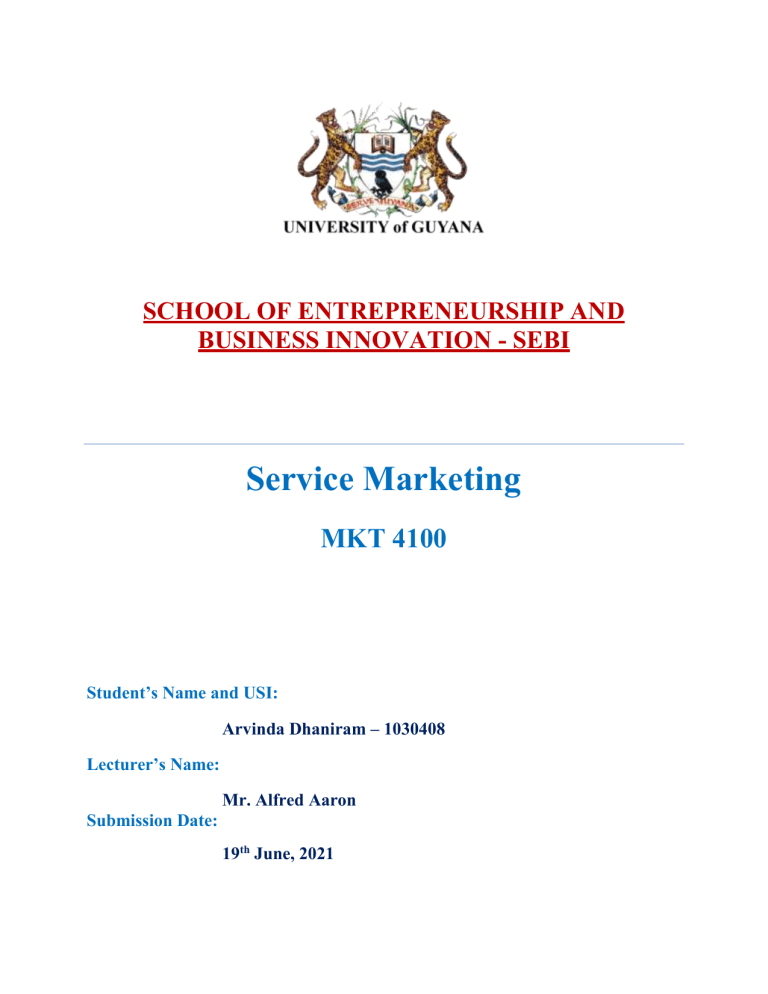
SCHOOL OF ENTREPRENEURSHIP AND BUSINESS INNOVATION - SEBI Service Marketing MKT 4100 Student’s Name and USI: Arvinda Dhaniram – 1030408 Lecturer’s Name: Mr. Alfred Aaron Submission Date: 19th June, 2021 Sullivan Ford Auto World Case Study A young healthcare manager unexpectedly finds herself running a family-owned car dealership in financial trouble. She is very concerned about the poor performance of the service department and wonders whether a turnaround is possible. Viewed from Wilson Avenue, the Sullivan Ford Auto World dealership presented a festive sight. Flags waved, and strings of triangular pennants in red, white, and blue fluttered gaily in the late afternoon breeze. Rows of new model cars and trucks gleamed and winked in the sunlight. Geraniums graced the flower beds outside the showroom entrance. A huge rotating sign at the corner of Wilson Avenue and Route 78 sported the Ford logo and identified the business as Sullivan Ford Auto World. The banners below urged, “Let’s make a Deal!” Inside the handsome, high-ceilinged showroom, four of the new model Fords were on display—a dark-green Explorer SUV, a red Mustang convertible, a white Focus sedan, and a red Ranger pick-up truck. Each vehicle was polished to a high sheen. Two groups of customers were chatting with salespeople, and a middleaged man sat in the driver’s seat of the Mustang, studying the controls. Upstairs, in the comfortably furnished general manager’s office, Carol Sullivan-Diaz finished running another spreadsheet analysis on her laptop. She felt tired and depressed. Her father, Walter Sullivan, had died of a sudden heart attack four weeks earlier at the age of 56. As executor of his estate, the bank had asked her to temporarily assume the position of general manager of the dealership. The only visible change that she had made to her father’s office was the installation of an all-in-one laser printer, scanner, copier, and fax machine. However, she had been very busy analyzing the current position of the business. Sullivan-Diaz did not like the look of the numbers on the printout. Auto World’s financial situation had been deteriorating for 18 months and running in the red for the first half of the current year. New car sales had declined, dampened in part by the poor macroeconomic environment. Margins had been squeezed by promotions and other efforts to move new cars off the lot. Reflecting rising fuel prices, industry forecasts of future sales were discouraging, and so were Sullivan-Diaz's own financial projections for Auto World’s sales department. Service revenues, which were below average for a dealership of this size, had also declined, although the service department still made a small surplus. Had she made a mistake the previous week, Carol wondered, in turning down Bill Froelich’s offer to buy the business? Admittedly, the amount was substantially lower than the offer from Froelich that her father had rejected two years earlier, but the business had been more profitable at that time. The Sullivan Family Walter Sullivan purchased a small Ford dealership in 1993, renamed it Sullivan’s Auto World, and built it up to make it one of the best-known car dealerships in the metropolitan area. In 2009, he borrowed heavily to purchase the current site at a major suburban highway intersection in an area of the city with many new housing developments. There had been a dealership on the site, but the buildings were 30 years old. Sullivan retained the service and repair bays but tore down the showroom in front of them and replaced it with an attractive modern facility. On moving to the new location, which was substantially larger than the old one, he renamed his business Sullivan Ford Auto World. Everybody seemed to know Walter Sullivan. He was a consummate showman and entrepreneur, appearing in his own radio and television commercials. He was also quite active in community affairs. His approach to car sales emphasized promotions, discounts, and deals in order to maintain volume. He was never happier than when making a sale. Carol Sullivan-Diaz, aged 28, was the eldest of Lovelock and Carmen Sullivan’s three daughters. After obtaining a bachelor’s degree in economics, she went on to take an MBA degree and then embarked on a career in healthcare management. She was married to Dr. Roberto Diaz, a surgeon at St. Luke’s Hospital. Her 20-year-old twin sisters, Gail and Joanne, who were students at the state university, lived with their mother. In her own student days, Sullivan-Diaz had worked part time in her father’s business on secretarial and book-keeping tasks and as a service writer in the service department. Thus, she was quite familiar with the operations of the dealership. At business school, she decided on a career in healthcare management. After graduation, she worked as an executive assistant to the president of St Luke’s, a large teaching hospital. Two years later, she joined Heritage Hospitals, a large multi-hospital facility that also provided long-term care, as the assistant director of marketing, a position she had held for almost three years. Her responsibilities included designing new services, handling complaints, conducting market research, and introducing an innovative day-care program for hospital employees and neighborhood residents. Carol’s employer had given her a six-week leave of absence to put her father’s affairs in order. She doubted that she would be able to extend that leave much beyond the two weeks still remaining. Neither she nor her other family members were interested in making a career of running the dealership. However, she was prepared to take time out from her healthcare career to work on a turnaround if that seemed a viable proposition. She had been successful in her present job and believed it would not be difficult to find another health-management position in the future. The Dealership Like other car dealerships, Sullivan Ford Auto World operated both sales and service departments, often referred to in the trade as “front end” and “back end” respectively. Both new and used vehicles were sold, since a high proportion of new car and van purchases involved trading in the purchaser’s existing vehicle. Auto World would also buy well-maintained used cars at auctions for re-sale. Purchasers who decided that they could not afford a new car would often buy a “pre-owned” vehicle instead, while shoppers who came in looking for used cars could sometimes be persuaded to buy new ones. Before being put on sale, used vehicles were carefully serviced, with parts being replaced as needed. They were then thoroughly cleaned by a detailer whose services were hired as required. Dents and other blemishes were removed at a nearby body shop, and the vehicle's paint work was occasionally re-sprayed as well. The front end of the dealership employed a sales manager, seven salespeople, an office manager, and a secretary. One of the salespeople had given notice and would be leaving at the end of the following week. The service department, when fully staffed, consisted of a service manager, a parts supervisor, nine mechanics, and two service writers. The Sullivan twins often worked part-time as service writers, filling in during busy periods, when one of the other writers was sick or on vacation, or when—as currently— there was an unfilled vacancy. The job entailed scheduling appointments for repairs and maintenance, writing up each work order, calling customers with repair estimates, and assisting customers when they returned to pick up their cars and pay for the work that had been done. Sullivan-Diaz knew from her own experience as a service writer that it could be a stressful job. Few people liked to be without their car, even for a day. When a car broke down or had problems, the owner was often nervous about how long it would take to get it fixed and, if the warranty had expired, how much the labor and parts would cost. Customers could be quite unforgiving if a problem was not fixed completely on the first attempt, thereby requiring them to return their vehicle for further work. Major mechanical failures were usually not difficult to repair, although the costs of replacing parts could be quite high. It was often the “little” things, such as water leaks and wiring problems, which were the hardest to diagnose and correct. Moreover, it was sometimes necessary for the customer to return two or three times before such a problem could be resolved. In these situations, parts and material costs were relatively low, but labor costs mounted up quickly, being charged out at US$75 an hour. Customers could sometimes be quite abusive, yelling at service writers over the phone or arguing with service writers, mechanics, and the service manager in person. Turnover in the servicewriter job was high, which was one reason why Carol—and more recently her sisters—had often been pressed into service by their father, to “hold the fort,” as he described it. More than once, she had seen an exasperated service writer respond sharply to a complaining customer or hang up on one who was being abusive over the telephone. Gail and Joanne were currently taking turns to cover the vacant position, but there were times when both of them had classes and the dealership had only one service writer on duty. By national standards, Sullivan Ford Auto World stood toward the lower end of medium-sized dealerships, selling around 1,100 cars a year, equally divided between new and used vehicles. In the most recent year, its revenues totaled US$26.6 million from new and used car sales and US$2.9 million from service and parts—down from US$30.5 million and US$3.6 million, respectively, in the previous year. Although the unit value of car sales was high, the margins were quite low, with margins for new cars being substantially lower than those for used ones. Industry guidelines suggested that the contribution margin (known as the departmental selling gross) from car sales should be about 5.5% of sales revenues and around 25% of revenues from service. In a typical dealership, 60% of the selling gross would traditionally come from sales and 40% from service, but the balance was shifting from sales to service. The selling gross was then applied to fixed expenses, such as administrative salaries, rent or mortgage payments, and utilities. For the most recent 12 months at Auto World, Sullivan-Diaz had determined that the selling gross figures were 4.6% and 24% respectively. Both these figures were lower than those of the previous year and insufficient to cover the dealership’s fixed expenses. Sullivan-Diaz's father had made no mention of financial difficulties, and she had been shocked to learn from the bank after his death that Auto World had been two months behind in mortgage payments on the property. Further analysis also showed that accounts payable had risen sharply in the previous six months. Fortunately, the dealership held a large insurance policy on Sullivan’s life, and the proceeds from this were more than sufficient to bring mortgage payments up to date, pay down all overdue accounts, and leave some funds for future contingencies. Outlook The opportunities for expanding new car sales did not appear promising, given declining consumer confidence and recent layoffs at several local plants, which were expected to hurt the local economy. However, promotional incentives had reduced the inventory to manageable levels. From discussions with Larry Winters, Auto World’s sales manager, Sullivan-Diaz had concluded that costs could be cut by not replacing the departing sales representative, maintaining inventory at its current reduced level, and trying to make more efficient use of advertising and promotion. Although Winters did not have Walter’s exuberant personality, he had been Auto World’s leading sales representative before being promoted and had shown strong managerial capabilities in his current position. As she reviewed the figures for the service department, Sullivan-Diaz wondered what potential might exist for improving its sales volume and selling gross. Her father had never been very interested in the parts-and-service business, seeing it simply as a necessary adjunct of the dealership. “Customers always seem to be miserable back there,” he had once remarked to her. “But here in the front end, everybody’s happy when someone buys a new car.” The service facility was hidden behind the showroom and therefore not easily visible from the main highway. Although the building looked old and greasy, the equipment itself was modern and well maintained. There was sufficient capacity to handle more repair work, but a higher volume would require the hiring of one or more new mechanics. Customers were required to bring cars in for servicing before 8:30 a.m. After parking their cars, customers entered the service building by a side door and waited for their turn to see the service writers, who occupied a cramped room with peeling paint and an interior window overlooking the service bays. Customers stood while work orders for their cars were prepared. Ringing telephones frequently interrupted the process. Filing cabinets containing customer records and other documents lined the far wall of the room. If the work was of a routine nature, such as an oil change or a tune-up, the customer was given an estimate immediately. For more complex jobs, customers would be called with an estimate later in the morning once the car had been examined. They were required to pick up their cars by 6:00 p.m. on the day the work was completed. On several occasions, Carol had urged her father to computerize the service work-order process, but he had never acted on her suggestions, so all orders continued to be handwritten on large yellow sheets, with carbon copies. Rick Obert, who was in his late forties, had held the position of Service Manager since Auto World had opened at its current location. The Sullivan family considered him to be technically skilled, and he managed the mechanics effectively. However, his manner with customers could be gruff and argumentative. Customer Survey results Another set of data that Sullivan-Diaz had studied carefully was the results of the customer satisfaction surveys that were mailed to the dealership every month by a research firm retained by Ford USA. Purchasers of all new Ford cars were sent a questionnaire by mail within 30 days of making the purchase and asked to use a five-point scale to rate their satisfaction with the dealership sales department, vehicle preparation, and the characteristics of the vehicle itself. The questionnaire asked the purchasers how likely they were to recommend the dealership, the salesperson, and the manufacturer to someone else. It also asked if the customers had been introduced to the dealer’s service department and been given explanations on what to do if their cars needed service. Finally, there were some classification questions relating to customer demographics. A second survey was sent to new car purchasers nine months after they bought their cars. This questionnaire began by asking customers if they were satisfied with the vehicle and if they had taken it to the selling dealer for service of any kind. If the response to the second question was affirmative, respondents were asked to rate the service department on 14 different attributes—ranging from the attitudes of service personnel to the quality of the work performed—and then to rate their overall satisfaction with the service from the dealer. The questionnaire also asked customers where they would go in the future for maintenance service, minor mechanical and electrical repairs, major repairs in those same categories, and bodywork. The options listed for service were the selling dealer, another Ford dealer, “some other place,” or “do it yourself.” Finally, there were questions about the customers' overall satisfaction with the dealer's sales department and the dealership in general as well as the likelihood of their purchasing another Ford product and from the same dealership or elsewhere. Dealers received monthly reports summarizing customer ratings of their dealership for the most recent month as well as for several previous months. To provide a comparison of how other Ford dealerships were performing, the reports also included regional and national rating averages. After analysis, completed questionnaires were returned to the dealership. Since these included each customer’s name, a dealer could see which customers were satisfied and which were not. In the 30-day survey of new purchasers, Auto World achieved better-than-average ratings on most dimensions. One finding that puzzled Carol was that almost 90% of respondents answered “yes” when asked if someone from Auto World had explained what they had to do if they needed service, but less than a third said that they had been introduced to someone in the service department. She resolved to ask Larry Winters about this discrepancy. The nine-month survey findings disturbed her. Although vehicle ratings were in line with national averages, the overall level of satisfaction with service at Auto World was consistently low, placing it in the bottom 25% of all Ford dealerships. The worst ratings for service concerned promptness of writing up orders, convenience of scheduling the work, convenience of service hours, and appearance of the service department. On length of time to complete the work, availability of needed parts, and quality of work done (“Was it fixed right?”), Auto World’s rating was close to the average. For interpersonal variables such as attitude of service department personnel, politeness, understanding of customer problems, and explanation of work performed, its ratings were relatively poor. When Sullivan-Diaz reviewed the individual questionnaires, she found that there was a wide degree of variation between customers’ responses on these interpersonal variables, ranging all the way across a five-point scale from “completely satisfied” to “very dissatisfied.” Curious, she went to the service fi les and examined the records for several dozen customers who had recently completed the nine-month surveys. At least part of the ratings could be explained with reference to the specific service writer the customer had dealt with. Those who had been served two or more times by her sisters, for instance, gave much better ratings than those who had dealt primarily with Jim Fiskell, the service writer who had recently quit. Perhaps the most worrying responses were those relating to how likely customers were to use Auto World’s service department in the future. More than half indicated that they would use another Ford dealer or “some other place” for maintenance service (such as oil change, lubrication, or tune-up) or for minor mechanical and electrical repairs. About 30% would use another source for major repairs. The rating for overall satisfaction with the selling dealer after nine months was below average, and the customer’s likelihood of purchasing from the same dealership again was a full point below that of buying another Ford product. Options Sullivan-Diaz pushed aside the spreadsheets she had printed out and shut down her laptop. It was time to go home for dinner. She saw the options for the dealership as basically twofold: either prepare the business for an early sale at what would amount to a distress price, or take a year or two to try to turn it around financially. In the latter instance, if the turnaround succeeded, the business could subsequently be sold at a higher price than it presently commanded, or the family could install a general manager to run the dealership for them. Bill Froelich, owner of another dealership located nearby plus three more dealerships in neighboring cities, had offered to buy Auto World for a price that represented a fair valuation of the net assets, according to Auto World’s accountants, plus $250,000 in goodwill. However, the rule of thumb when the auto industry was enjoying good times was that goodwill should be valued at $1,200 per vehicle sold each year. Carol knew that Froelich was eager to develop a network of dealerships in order to achieve economies of scale. His prices on new cars were very competitive, and his nearest dealership clustered several franchises—Ford, LincolnMercury, Volvo, and Jaguar—on a single large property. An Unwelcome Disturbance As Carol left her office, she spotted the sales manager coming up the stairs leading from the showroom floor. “Larry,” she said, “I’ve got a question for you.” “Fire away!” replied the sales manager. “I’ve been looking at the customer satisfaction surveys. Why aren’t our sales reps introducing new customers to the folks in the Service Department? It’s supposedly part of our sales protocol, but it only seems to be happening about one-third of the time!” Larry Winters shuffled his feet. “Well, Carol, basically I leave it to their discretion. We tell them about service, of course, but some of the guys on the floor feel a bit uncomfortable taking folks over to the service bays after they’ve been in here. It’s quite a contrast, if you know what I mean.” Suddenly, the sound of shouting arose from the floor below. A man of about 40, wearing a windbreaker and jeans, was standing in the doorway yelling at one of the salespeople. The two managers could catch snatches of what he was saying, in between various obscenities: “… three visits … still not fixed right … service stinks … who’s in charge here?” Everybody else in the showroom stopped what they were doing and turned to look at the newcomer. Winters looked at his young employer and rolled his eyes. “If there was something your dad couldn’t stand, it was guys like that, yelling and screaming in the showroom and asking for the boss. Walt would go hide out in his office! Don’t worry, Tom’ll take care of that fellow and get him out of here. What a jerk!” “No,” said Sullivan-Diaz, “I’ll deal with him! One thing I learned when I worked at St. Luke’s was that you don’t let people yell about their problems in front of everybody else. You take them off somewhere, calm them down, and find out what’s bugging them.” Exhibit 1: Marketing cars is a different proposition than marketing services for the same vehicles. She stepped quickly down the stairs, wondering to herself, “What else have I learned in healthcare that I can apply to this business?” Questions 1. How does marketing cars differ from marketing service for cars? 2. Compare and contrast the sales and service departments at Auto World. 3. From a consumer's perspective, what useful parallels do you see between operating a car sales and service dealership and operating health services? 4. What advice would you give to Carol Sullivan-Diaz? 1. How does marketing cars differ from marketing service for cars? The automobile industry is quite different from a distribution industry for food products, it requires more intrapersonal and interpersonal skills marketing and promoting this type of service that you want to provide. Marketing cars differs from the method of marketing services. Marketing cars can be done in the orthodox way of marketing. Marketing cars works with the marketing mix, which attempt to control the 4P’s (Product, Place, Price, Promotion). Automobile or the cars are tangible products that are being sold in unit. The procedure of production a car and consumption or usages of a car are separated process. On the other hand, marketing a service for a car includes the 7P’s (Product, Place and Time, Price, Promotion and Education, Physical Environment and People). Service industries face more challenges than its product counterpart because of the people factor. Marketing a car will usually emphasis on the buying process of the consumer, involving transection, to take ownership of the product. On the other hand in service, monetary transection, time and effort are exchange for labor or skills, but the ownership of the product is not seen or heard of but a service is an intangible product that must offer superior service in order to hold a competitive advantage. Products and Service can differ in many aspects: Intangibility Inseparability Non-standardization Perishability Regulation Word-of-Mouth Marketing a car is easy because the product can be seen, touched or can be experienced. Through pictures and illustrations, customers can already see the features of the product. Or can Experience the product on their own. On the other hand, as the service is can’t be seen or heard off; making it tough for the customers to imagine what will actually happen if they get the service. Car servicing need skill manpower and experienced labor. Here, product is the primary player. Another difference of marketing a car from marketing a service is that, the latter cannot be inventoried, which may cause customers to wait or not to avail the service anymore. Moreover, marketing for car and marketing for service needs different people from different skill sets. One personal will be skilled on automobile market while other will focus on customer satisfaction.
